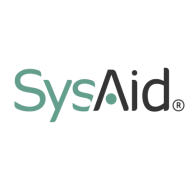

JIRA Service Management and SysAid both compete in the service management category. JIRA appears to have an upper hand with its powerful integration capabilities, while SysAid is favored for its cost-effectiveness, especially for mid-size organizations.
Features: JIRA Service Management provides comprehensive customization capabilities, robust integration options, and an extensive add-on marketplace, supporting complex workflows and automation. SysAid offers built-in asset management, ease of use, smooth ticket management, and integration with other software applications, catering to diverse service desk needs.
Room for Improvement: JIRA Service Management faces challenges with certain integrations and lacks advanced built-in features without costly add-ons, alongside a complex customization process. SysAid's mobile application and AI capabilities require enhancements, and its user interface could benefit from modernization, along with improved reporting and security features.
Ease of Deployment and Customer Service: JIRA Service Management offers deployment on public, private, and hybrid clouds but has variable technical support responsiveness. SysAid supports on-premises and private cloud deployments with a straightforward deployment process, earning positive feedback for effective customer service, particularly in smaller IT environments.
Pricing and ROI: JIRA Service Management's higher pricing is justified by its comprehensive feature set but includes high add-on costs. It offers significant ROI through improved efficiency and team visibility. SysAid, known for competitive pricing, promises quick ROI with cost-effective, reasonable out-of-box functionalities.
| Product | Market Share (%) |
|---|---|
| JIRA Service Management | 7.4% |
| SysAid | 1.1% |
| Other | 91.5% |


| Company Size | Count |
|---|---|
| Small Business | 30 |
| Midsize Enterprise | 23 |
| Large Enterprise | 33 |
| Company Size | Count |
|---|---|
| Small Business | 5 |
| Midsize Enterprise | 1 |
| Large Enterprise | 4 |
JIRA Service Management is Atlassian’s IT service management (ITSM) solution. It unlocks all teams at high velocity by:
1. Accelerating the flow of work between IT teams, development teams, and business teams
2. Empowering teams to deliver their service more quickly
3. Bringing visibility to their work
Built on JIRA, JIRA Service Management enables best practices across request, incident, problem, change, knowledge, asset, and configuration management so that teams can streamline collaboration between themselves. More than 30,000 customers of all sizes rely on JIRA Service Management to deliver service.
JIRA Service Management Features
JIRA Service Management has many valuable key features. Some of the most useful ones include:
JIRA Service Management Benefits
There are many benefits to implementing JIRA Service Management. Some of the biggest advantages the solution offers include:
Reviews from Real Users
JIRA Service Management stands out among its competitors for a number of reasons. Some of these include its stability, its easy customization, and its seamless integration with other solutions. PeerSpot users take note of the advantages of these features in their reviews:
Abhishek S., a Program Lead at PureSoftware, writes of the solution, “You can scale the solution whether it is deployed to the cloud or the data center. While we might have up to 5,200 people using the solution, we do not require that many licenses, as only those dealing with the tickets are required to be licensed.”
Andrew B., a Technical Engineer at a consultancy firm, notes, “One of the valuable features is that an automatic response or action can be taken on tickets. We can have certain responses for tickets that contain keywords or are logged and tagged with certain labels.”
Offered in both cloud and on-premise versions, SysAid is a globally-adopted IT Service Management (ITSM) solution that combines all the essential capabilities in one, feature-rich tool. From traditional ticket management to asset management, SysAid allows administrators to monitor and manage tasks in one platform, so they can deliver fast and comprehensive support from a single view. Available in 42 languages, SysAid serves over 10,000 customers across 140 countries, spanning all industries and sizes.
We monitor all Help Desk Software reviews to prevent fraudulent reviews and keep review quality high. We do not post reviews by company employees or direct competitors. We validate each review for authenticity via cross-reference with LinkedIn, and personal follow-up with the reviewer when necessary.